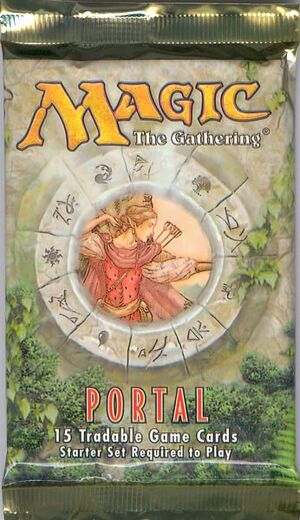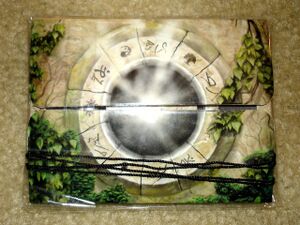Portal: Difference between revisions
>WikiGnome-gpuser m (prod page link) |
|||
| Line 158: | Line 158: | ||
==External links== | ==External links== | ||
*[http://www.wizards.com/magic/starter/portal/welcome.asp Portal Product Page] (old) | *[http://www.wizards.com/magic/starter/portal/welcome.asp Portal Product Page] (old) | ||
*{{Prodpage| | *{{Prodpage|node=115073|Portal}} (new) | ||
*{{DailyRef|mtgcom/arcana/546|Portal Instants|Wizards of the Coast|April 15, 2004}} | *{{DailyRef|mtgcom/arcana/546|Portal Instants|Wizards of the Coast|April 15, 2004}} | ||
*{{DailyRef|mtgcom/arcana/184|Portal Goodness|Wizards of the Coast|September 16, 2002}} | *{{DailyRef|mtgcom/arcana/184|Portal Goodness|Wizards of the Coast|September 16, 2002}} | ||
Revision as of 12:52, 9 August 2016
| Portal | |
|---|---|
| Set Information | |
| Set symbol | |
| Set size |
215 (20 basic lands, 85 commons, 55 uncommons, 55 rares) |
| Expansion code | POR[2] |
| Development codename | Harvey |
Portal is a starter-level set released on May 1, 1997.[3] It was Wizards of the Coast's first major attempt at a set catering to prospective and newer players. It was designed to provide them a format with simpler rules than a core set or an expansion set.

Set details
Portal contains 215 black-bordered cards (55 rare, 55 uncommon, 85 common, and 20 lands).
In an effort to facilitate learning Magic, Portal was markedly aesthetic and mechanically differently from previous non-starter-level sets. To simplify game play, Portal featured no instants, enchantments, or artifacts and, subsequently, had a simpler set of rules. Some sorceries could be played outside the normal timing rules for sorceries, and these cards received errata as appropriate.[4] Creature cards printed in Portal featured no creature types, and their type line read "Summon Creature". These cards also received errata.
Portal also featured different terminology from that established in previous sets. These terms included "intercepting" for blocking, "deck" for library, "discard pile" for graveyard, "offense" for power, and "defense" for toughness. Although these new terms were intended to simplify learning Magic, particularly as a stepping stone for more complex sets, they were a source of distress for players if and when they started to use advanced-level and/or expert-level cards, which do not use this terminology. Cards featuring these terms also received errata but are otherwise functionally the same.
To facilitate interpreting cards, the established layout was changed such that the power/toughness parameters printed on creature cards were accompanied by sword and shield symbols to more readily clarify the meaning of these numbers. Furthermore, rules text was in bold type to distinguish it from flavor text. Moreover, a thick line was drawn between rules text and flavor text to reinforce the distinction.
In the beginning, many on the design team were confused about the expectations behind the Portal concept. As a joke, they named it "Harvey", after the invisible rabbit in the famous play and movie. Like the fictional Harvey, Portal at the time was big, invisible, and no one knew what it was.[5]. Portal was not a legal set for official tournament play in any organized format until October 20, 2005, when it and other starter-level sets were made sanctioned for Legacy and Vintage formats.[6]
Marketing
Portal was advertized as a beginners version of the game. Aside from Portal boosters (1 rare, 3 uncommon, and 11 common cards), there is a Portal 2 Player Starter Set in existance. 7 of the Portal cards included in the Starter Set feature additional rules text and are therefore different from their booster pack counterparts. Portal boosters feature artwork from one Merfolk of the Pearl Trident, Elvish Ranger and Spined Wurm.
Each Portal booster contained one of ten different strategy cards with deck-building tips. There are 5 strategies described in all, one for each of the five friendly color pairs. Each of these five strategies has two different versions. :
 /
/ — Air Superiority
— Air Superiority /
/ — Card Domination
— Card Domination /
/ — Fiery Doom
— Fiery Doom /
/ — Gargantuans
— Gargantuans /
/ — The Horde
— The Horde
Portal Demogame boosters were given away as a free product to advertise Magic. Out of the 24 Portal cards they contain, 6 cards feature additional rules text and are therefore slightly different from their counterparts found in booster packs. Portal Demogame boosters were also offered in the Guru program. the Official Guide to Portal explained the rules, featured an overview of the set with reproductions of all the cards, and hints on succesful strategies for play and deck construction.


WotC launched a major advertsing campaign, including commercials on MTV and popular TV shows, to introduce Magic to a major audience. They expected some players to stick with Portal but most to learn with it and the move on to standard Magic. As it turned out, most people learning Portal were taught by experienced players. When those players used standard rules and terms rather than the Portal ones, the differences caused confusion. This would be rectified in Portal Second Age.
Flavor and storyline
No specific storyline was developed for Portal, but flavor is conveyed throughout the flavor texts of cards.
Themes and mechanics
Portal introduces no new themes or mechanics to Magic, and was essentially the same game introduced in Limited Edition, with exception to the absence of instants, enchantments, and artifacts.
Pairs
Matched pairs
- Armageddon and Wrath of God are both white sorceries with a CMC of 4 that destroy all permanents of a specific card type.
- Baleful Stare and Withering Gaze are both blue sorceries costing

 and allow their controllers to draw cards equal to the number of cards of a specific enemy color and land cards of a specific basic land type associated with an enemy color.
and allow their controllers to draw cards equal to the number of cards of a specific enemy color and land cards of a specific basic land type associated with an enemy color. - Boiling Seas and Flashfires are both red sorceries costing

 and destroy all lands of a specific basic land type associated with an enemy color.
and destroy all lands of a specific basic land type associated with an enemy color.
Mirrored pairs
- Earthquake and Hurricane are both rare sorcery spells costing
 C and deal X damage to each creature with/without flying and each player.
C and deal X damage to each creature with/without flying and each player.
Reprinted cards
The following cards have been reprinted from previous sets and included in Portal:
|
|
Functional reprints
Portal has seven functional reprints:
- Bee Sting is a functional reprint of Unyaro Bee Sting from Mirage.
- Border Guard is a functional reprint of Femeref Scouts from Mirage.
- Cruel Bargain is a functional reprint of Infernal Contract from Mirage.
- Lizard Warrior is a functional reprint of Viashino Warrior from Mirage.
- Pillaging Horde is a functional reprint of Balduvian Horde from Alliances.
- Raging Minotaur is a functional reprint of Talruum Minotaur from Mirage.
- Willow Dryad is a functional reprint of Shanodin Dryads from Fifth Edition.
Since there are no instants in Portal some cards were reprinted as sorceries:
- Fire Tempest is a sorcery version of Inferno from Fifth Edition.
- Last Chance is a sorcery version of Final Fortune from Mirage.
- Mobilize is a sorcery version of Vitalize from Weatherlight (which was released at the same time).
- Sylvan Tutor is a sorcery version of Worldly Tutor from Mirage.
- Temporary Truce is a sorcery version of Truce from Fifth Edition.
- Touch of Brilliance is a sorcery version of Inspiration from Visions.
- Warrior's Charge is a sorcery version of Warrior's Honor from Visions.
Preconstructed decks
For the content of the decks, see Portal 2 Player Starter Set.
Notable cards
While Portal was full of vanilla creatures and simple spells, a few of its cards have had some impact on Magic as a whole and on the Core Sets in particular:
- Blaze — a Core Set staple, was first printed in Portal.
- Ebon Dragon — Although it is not a particularly powerful card, its art has made it one of the most popular and valuable cards in the set.
- Exhaustion — was first printed in the set and has since been reprinted in Urza's Saga and 9th Edition.
- Jungle Lion — is considered one of the stronger cards in the set, its power and mana cost being on a par with Savannah Lions, Elite Vanguard and Jackal Pup. However, it has seen little play since Portal was made tournament-legal.
- Lava Axe — has been reprinted multiple times.
- Personal Tutor — was pre-emptively restricted when Portal was legalised in Vintage due to the power of tutor effects in the format. However, the other tutors in the set (Cruel Tutor and Sylvan Tutor) were not.
- Phantom Warrior — has gone on to become a core set staple.
- Raging Goblin — is another iconic red card and core set staple.
- Snapping Drake — was reprinted in Ravnica, where it was often a good pick in Limited.
- Volcanic Hammer — has gone on to be reprinted in three core sets and has appeared in high-tier 'Vore decks.
- Wind Drake — is another core set staple.
- Wood Elves — has seen Standard constructed play due to their ability to fetch Shocklands.
References
- ↑ Template:NewRef
- ↑ [1]
- ↑ Portal Spoiler Card List — Wizards of the Coast
- ↑ Magic Arcana (April 15, 2004). "Portal Instants". magicthegathering.com. Wizards of the Coast.
- ↑ Mark Rosewater. (March 1998). Insider Trading, The Duelist #23
- ↑ Aaron Forsythe (March 11, 2005). "More About March 1st". magicthegathering.com. Wizards of the Coast.
External links
- Portal Product Page (old)
- Portal product information page — Wizards of the Coast (new)
- Wizards of the Coast (April 15, 2004). "Portal Instants". magicthegathering.com. Wizards of the Coast.
- Wizards of the Coast (September 16, 2002). "Portal Goodness". magicthegathering.com. Wizards of the Coast.